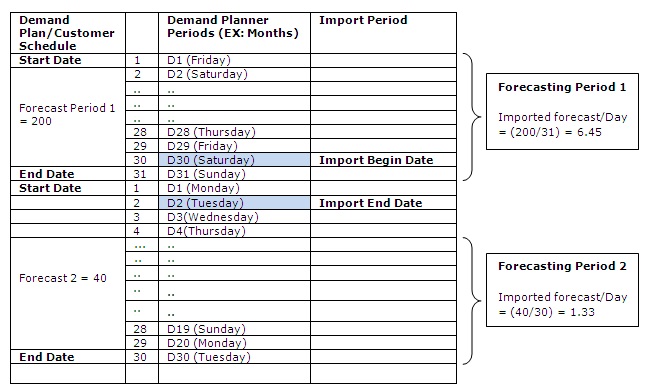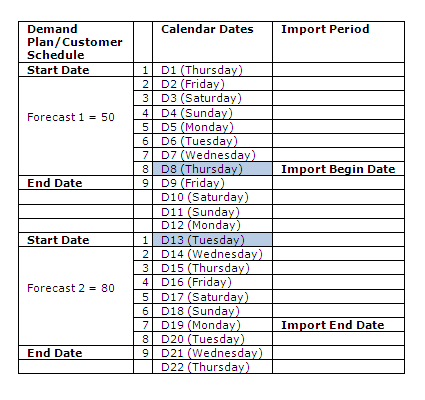Import Demand Planning/Customer Schedule Forecasts
The purpose of importing forecasts from demand planner or customer schedules is to provide an alternative to the manual entry of forecasts for master scheduled level 1 parts and MRP planned spare parts. The manual process can be repetitive and tedious, especially for the forecasts that must be maintained weekly. Importing previously generated forecasts, either online or in the background greatly reduces the quantity of time that you spend entering and maintaining forecasts. With this option, you may choose to maintain a forecast manually, before or after the forecast has been imported.
Once the import process is completed, you can analyze its results in the appropriate Master Scheduling or MRP pages. You can view the imported forecasts and can change or delete some or all of them according to the needs. You will have to manually alter imported forecast at times to make the forecast more realistic according the current production and market conditions. For example, the forecasts generated by the demand planner and imported to master scheduling cannot be achieved based on the production capacities or the imported forecasted quantities itself that does not match with the current market fluctuations.
The following are key terms that relate to the import process:
| Term | Definition |
| Begin Date and End Date | The dates that you enter in the Import Demand Planning Forecasts or Import Customer Schedules to indicate the time span for which you want to import forecasts. |
| Start Date and End Date | The dates that appear in Exported Forecasts to indicate the period covered by forecasts. |
| Delivery Date/From Date and To Date | The dates that appear in Customer Schedule to indicate the period covered by forecasts. |
| Starting Date and Ending Date | The dates that the system uses to calculate the imported forecast quantity. |
You import forecasts into Master Scheduling or MRP from Exported Forecasts or Customer Schedule. The Import Demand Planning Forecasts or Import Customer Schedules lets you specify the import parameters where you defined the date range for which the imports of forecasts should take place. The results appear in the appropriate MRP or Master Scheduling page.
Several factors determine the time period for which the forecasts are imported. For a spare part in MRP, you can specify this period by defining the Begin Date and End Date in Import Demand Planning Forecasts for Spare Parts. Same naming is used in Import Customer Schedules which uses to import customer schedule forecasts to Master Scheduling Level 1. It is also possible to enter the start and end dates to the Date Range field in Import Demand Planning Forecasts as well.
For a level 1 part in Master Scheduling, you indicate whether the time period should include forecasts inside the planning time fence (PTF). If you do not request forecasts inside the planning time fence (PTF), the system will import all forecasts outside the planning (PTF) along with all forecasts through the specified End Date. If you request forecasts inside the PTF planning time fence (PTF), the system will import all forecasts outside the demand time fence (DTF).
The Exported Forecasts or Customer Schedule includes columns for Start Date and End Date. The dates in these columns may be different from the Begin Date and the End Date that you entered in Import Demand Planning Forecasts or Import Customer Schedules. When this occurs, the system calculates the forecast quantity using the formulas shown below.
How the Imported Forecast Quantity is Calculated
The imported forecast quantity depends on the following factors:
- The Forecast Type (either Budget or Regular) in Exported Forecasts.
- Number of days (working days for MRP spares) included in the specified time period for importing.
- Whether or not the Start Date/From Date and the End Date/To Date in Exported Forecasts or Customer Schedule are the same as the Begin Date and the End Date specified in Import Demand Planning Forecasts for MS or MRP or Import Customer Schedules.
- Whether or not you have requested the inclusion of forecasts inside the planning time fence (PTF).
The formula for determining the imported forecast quantity is as follows:
Forecast quantity imported = Forecast or budget quantity / n, where n is the number of days (working days for MRP spares) between the Start Date/From Date and End Date/To Date specified in Exported Forecasts or Customer Schedule.
Furthermore, for Master Scheduling Level 1 parts the imported forecast proportion does not depend on the manufacturing calendar and does not differ with the working and non-working days included in the given date range. Instead, it will forecast the actual proportion of the imports by dividing the actual forecasted quantity of the period from the number of days defined by the Start Date and End Date of the given Date Range and insert it on the particular Begin Date depending on the forecast distribution method.
How the Starting and Ending Dates are Calculated
The Starting Date for each of the items below is as follows:
- Spare Part: The Start Date or the Begin Date, whichever is greater, is used as the Starting Date for calculating forecast quantities.
- Level 1 Part Without a Request for Forecasts Inside the PTF: The Start Date, Begin Date, or PTF + 1, whichever is greatest, is used as as the Starting Date for calculating forecast quantities.
- Level 1 Part With a Request for Forecasts Inside the PTF: The Start Date, Begin Date, or DTF+1, whichever is greatest, is used as the Starting Date for calculating forecast quantities.
- Spare Part or Level 1 Part for Which the Starting Date Is Not a Workday: The closest previous workday is used as the Starting Date for calculating forecast quantities. If this date does not exist on the manufacturing calendar, then the closest subsequent workday is used. If neither date can be found, an error message appears.
The Ending Date is as follows:
- Spare Part and Level 1 Part: The End Date that was entered in the Import Demand Planning Forecasts dialog box or the End Date in Exported Forecasts, whichever is smaller, is used as the Ending Date for calculating forecast quantities.
How Each Distribution Method Imports the Forecast Quantity
The distribution method is one of the import parameters that you specify in the Import Demand Planning Forecasts dialog box. The distribution method controls how the system distributes and displays the imported data.
- Start Date/As Is Distribution Method
- Daily Distribution Method - Only in Import Demand Planning Forecasts
Each forecast in Exported Forecasts or Customer Schedule has a Start Date/From Date and an End Date/To Date to indicate the time period of the forecast. With the Start Date/As Is distribution method, the Start Date/From Date appears as the forecast date for each forecast. Each quantity from different forecasts are divided by the total number of days (workdays for MRP spares) which each quantity belongs to, and take the individual portion to decide the quantity to be imported on the particular forecast date. Individual portion is multiplied by the number of days (workdays for MRP spares) from each forecast that falls into the given date range to decide the actual quantity to be imported on the Start Date. If the Date Range consists of two different forecasting periods defined by the Start date/From Date and the End Date/To Date, each forecasted value should be entered into the relevant Start Date of the particular forecast. In MRP spares if the forecast date is a non-working day then the forecast will be entered into the previous work day. In Master scheduling, forecast will be entered into the Start Date even if it is a non-working day.
Following is an example of how this works:
Import Begin Date and End Date falls into two different forecasting periods.
The imported forecasts are distributed and displayed on each day (workday for MRP spares) within the specified time period. The system calculates the daily forecast quantity by dividing the total imported forecast quantity by the number of days (workdays for MRP spares) which each forecast belongs to and insert each imported forecast on every day (working day for MRP spares) in the Date Range for the import. The system rounds up any fractional quantities and carries over any overages to the next day (next workday for MRP spares).
The following is an example of how this works.

The system calculates the imported forecast as follows:
| Forecast Date | Calculation | Distributed Forecast |
| D31 (Period 1) | 6.45 ->rounded to 7, overage = 0.55 | 7 |
| D30 (Period 1) | 6.45 -0.55 = 5.9 -> rounded to 6, overage=0.1 | 6 |
| D1 (Period 2) | 1.33-0.1=1.23 -> rounded to 2, overage=0.77 | 2 |
| D2 (Period 2) | 1.33-0.77 =0.56 -> rounded to 1, overage=0.44 | 1 |
| And so on | . |
- Weekly Distribution Method
For the first week in the specified Date Range, the forecast is distributed and displayed on the Starting Date. (You can refer how starting and ending dates are calculated in the above section). For the following and each subsequent week, the imported forecast is distributed on Monday. The forecast quantity for each week is the sum of the forecast quantity for each day (working day for MRP spares) in the week. When it comes to MRP spares, if Monday is not a workday, then the forecast is added to the forecast of the previous week and displayed it on either the previous Monday or the Starting Date. If the forecast for the previous week does not exist, an error message will appear as well.
The following example uses data from the previous example to illustrate the weekly distribution method.

Distribution period falls into the Date Range where the Start Date is on D8 and End Date is on D19. Date Range consists of two different forecasting periods.
Using the above information, the system calculates the imported forecast as follows:
Imported Forecast = (Quantity/n)*N, where
Quantity = forecast quantity for the forecasting period
n = Number of days (work days for MRP spares for the forecasting period)
N = Number of days (working days for MRP spares) in import period within forecasting period.
| Forecast Date | Calculation | Distributed Forecast |
| D8 (Start Date) | 5.55*2-> 11.1 rounded to 12, overage = 0.9 | 12 |
| D12 (Monday) | (8.88*6 -0.9) ->52.38 rounded to 53, overage 0.62 | 53 |
| D19 (Monday) | 8.88-0.62 ->8.26 rounded to 9, overage 0.74 | 9 |
Import Forecast by Customer Dimension
When importing forecasts from Demand Planner you can either import
the total forecast for each part or import forecasts per part and customer
dimension.
When you import by part only, the forecasts will be imported
straight into the Master Schedule by Part page.
When you import by Customer Dimension, the forecasts will be
imported to the Master Schedule by Customer Dimension page. However, since
these forecasts are automatically aggregated, they will also appear as total
forecasts in the Master Schedule by Part page.
Forecasts will be imported for the customer dimension (Customer,
Customer Stat Group, Market, Region, District or Country) that has been
defined in the Demand Planner flow.
Dates, calculations and distribution described earlier in this
document is applicable also for import by Customer Dimension.
Import by Customer Dimension is available only from Demand Planner,
not Customer Schedules or MRP Spare Parts.
